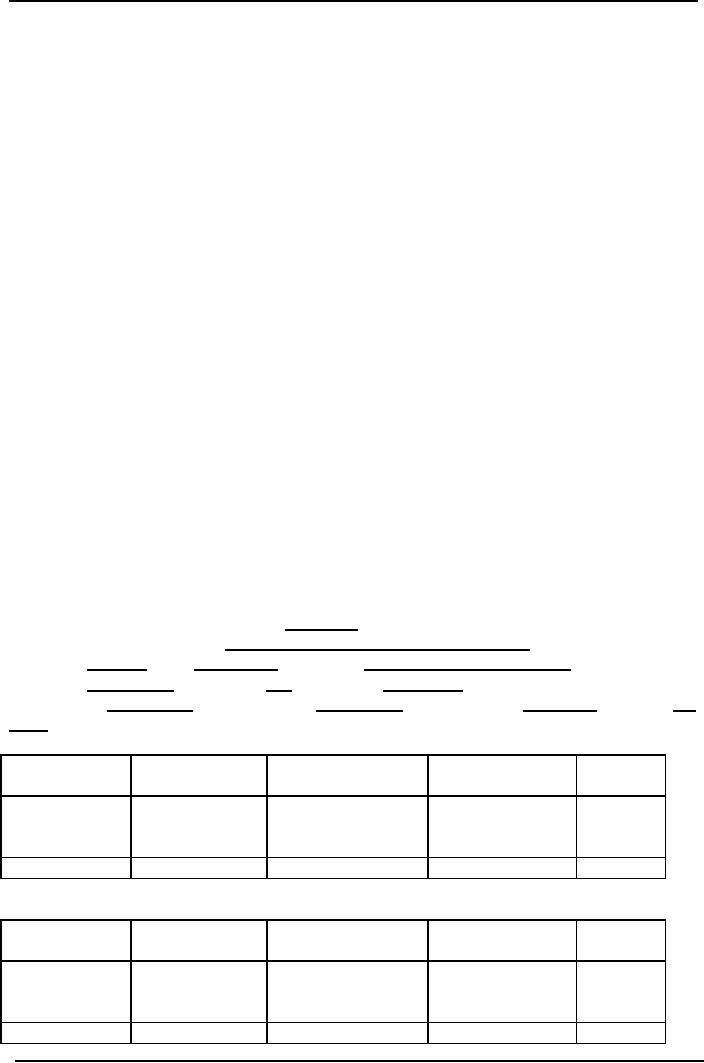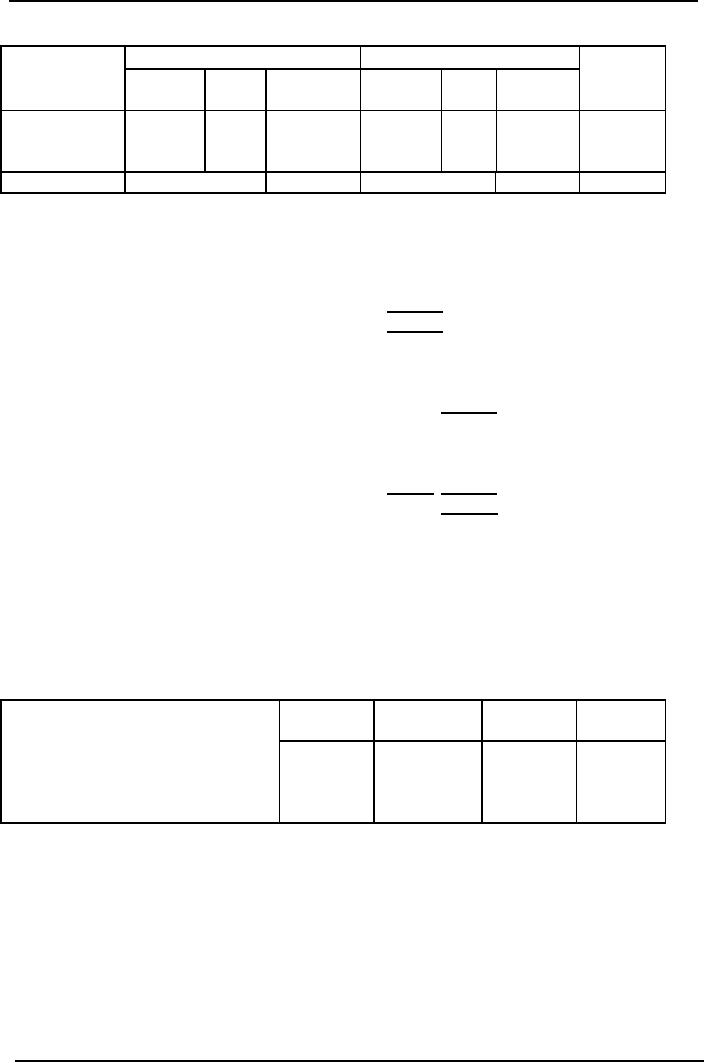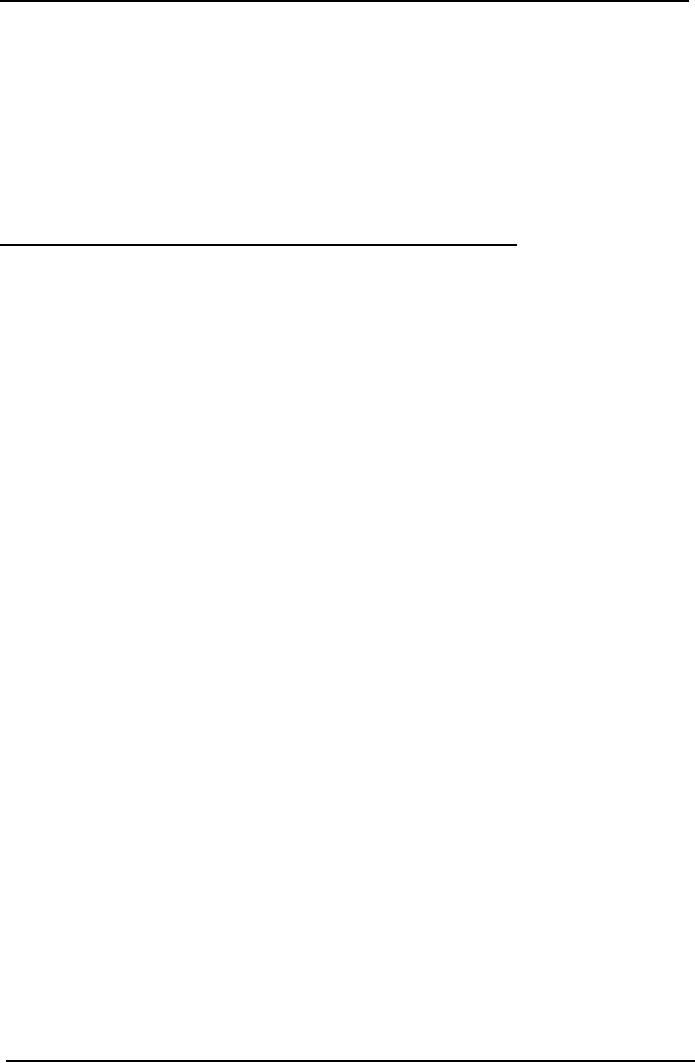 |

Cost
& Management Accounting
(MGT-402)
VU
LESSON#
18
JOB
ORDER COSTING
SYSTEM
It has
been explained that a cost
accounting system is composed of
two sub-systems:
(i)
A
system of recording and summarizing
costs and
(ii)
A
costing system.
Costing
system means "the
ascertainment of costs ", It includes
determination of total cost as
well as
unit
cost. A costing system determines
and reports to management
total and unit cost of
product
or
project of service with
details of cost
components
Costing
is compulsory for satisfying at least
three important needs of
management.
I.
Unit cost must be known to
assist the management in making
price decisions.
II.
Ascertainment of cost at every stage of
production is important for
exercising control
over
costs.
III.
In order to operate a system of
accounting for costs,
management needs to know
cost of
materials,
labor and overhead to be
charged to work in process,
cost of work completed
and
transferred to finished goods
and the cost of goods sold
so that necessary debit
and
credit
entries can be
passed.
Choice
of a Costing System
Job
Order Costing or Process
Costing?
What
type of costing system an accounting
entity should adopt? It
depends upon:
(1)
Nature
of operations and
(2)
Information
needs of management.
Take
the example of a construction
company that produces houses
in response to customers'
orders
and according to their
specifications. All the
times, the company remains
engaged in the
construction
of many houses at different
sites for different customers.
Such a company
definitely
wants
to know the cost incurred on
each house separately so
that customers' can be billed
properly
and
profit (or loss) on each
contract may be ascertained.
Here the nature of operations is such
that
each
house is clearly distinguishable from the
other and separate
calculation of cost for each
house
is
desirable and practically possible.
This company will employ
job costing system.
On
the other hand take
the example of a company
producing cement. All of the
bags of cement
produced
are quite similar. Here
separate calculation of cost of cement
supplied to each
customer
is neither desirable nor
feasible. The company can
calculate cost per bag of
cement
produced
by dividing total cost
incurred during the
accounting period by total number of
bags
produced
during the period.
Accordingly,
the company can fix
the price per bag
and bill each customer
according to the
number
of bags supplied to him. This
company will use process
costing system.
Job
costing and process costing are
two basic types of costing
systems and can be
viewed
as
two ends of a spectrum or range. In
practice we find companies
employing either one of
these
two or some combination of
features of the two both of
these at the same time.
For
example,
a ready made garments
manufacturer employs process costing to
accumulate and
determine
the cost of free size shirts
produced by him in large quantity. At
the same time he
uses
job costing to accumulate the
cost of waiters' uniforms supplied to a
hotel under a
contract.
Job
costing may be
defined:
The
costing system that separately
accumulates costs incurred to produce each job in a
situation where each job is
distinguishable
from the other throughout the
production process.
The
job may be a single unit or
a multi unit batch, a contract or a
project, program or a service.
Job
costing
is employed by organisations possessing
following characteristics:
1.
Production is generally in response of customers'
orders.
2.
Every order has its own
manufacturing specifications. Therefore,
every job is different from
the
other
and requires different
amounts materials, labor and
overhead.
127

Cost
& Management Accounting
(MGT-402)
VU
3.
Each job is clearly distinguishable from
the other at all stages
production process which
makes
job-wise
accumulation of possible.
4.
Job-wise accumulation of cost is
desirable and/or necessary
for and profit determination
and
5.
Each job is generally of high
value.
Following
are the examples of
organisations employing job costing
include:
a)
Accounting firms
b)
Civil engineering
c)
Furniture manufacturing
d)
Medical care
e)
Printing press
f)
Ship-building
g)
Advertising agencies
h)
Computer programming
i)
Jewellery manufacturing
j)
Movie studios
k)
Repair shops
As
the costs are accumulated
separately for each job,
therefore, job costing requires
considerable
amount
of clerical work. Where production is
carried in different departments of a
factory,
department
wise cost accumulation is
also necessary for
performance evaluation of
departmental
management.
In this way clerical work is
further increased. Consequently,
job costing is more
expensive
as
compared with process costing.
Job costing is also called
specific order costing or
production
order costing.
Job
order costing
procedures
Most
of the times, organisations
employing job order costing
are required to submit
quotation
before
finalization of customer's order.
Therefore, naturally, the
first step in job order
costing is to
prepare
an estimate of cost likely to be
incurred to produce the job.
The estimation is done by
coordination
of sales, designing and
production departments. On the basis of
estimated cost price
is
quoted. When customer's order has
been initialized production
planning and control
department
takes the first step towards
execution of the
order.
On
receipt of production order,
cost accounting department
prepares a job cost sheet
for each
job.
Job cost sheet may be
defined as a
document used for accumulating costs
incurred to produce a job.
Design
and contents of job cost
sheet vary widely depending
on customs of manufacturing
operations
and information needs of
management.
However,
generally, a job cost sheet is
designed to show the
following information:
1.
Job number
2.
Name of the customer
3.
Description and specifications of
the job
4.
Date of commencement of production
5.
Date of completion of job.
6.
Direct materials cost
incurred on the job
7.
Direct labor cost incurred
on the job
8.
Factory overhead applied to
the job
9.
Total cost of the
job
10.
Selling and administration
expenses chargeable to the
job
11.
Sales price of the
job
12.
Profit (or loss) on the
job
13.
Where the job consists of a batch,
the quantity produced and
unit cost
14.
Where cost estimates are
prepared before production, estimated
cost should also be shown
for
comparison
and efficiency
evaluation.
128

Cost
& Management Accounting
(MGT-402)
VU
Job
cost sheet is one of the
basic
documents used
in job order costing. Upto
the time the job
is
incomplete;
job
cost sheet serves as a
subsidiary
record .for work in process control
account and is
placed in
work
in process subsidiary ledger. On
completion
of
job, the relevant job
cost sheet is removed
from
work in process subsidiary
ledger.
Now
it reveals the cost of completed
job and serves as source
document for
debiting finished goods
account
(or completed jobs control account)
and for crediting work in
process account.
Then
it is placed in finished goods
subsidiary ledger and serves
as subsidiary
record .for finished
goods
account.
When
completed job is shipped to the
customer, relevant job cost
sheet serves as source
document
for
debiting cost of goods sold account
and for crediting finished
goods account. Then
it
is
placed in cost of goods sold
subsidiary ledger where the
same job cost sheet
serves as subsidiary
record
for cost of goods sold
account.
Manufacturing
process is, most of the
times, divided into departments. This
departmentalization
is
the logical result of different
types of operations performed to produce a
product. For example,
furniture
manufacturing is divided into cutting,
assembling and finishing and
polishing
departments;
readymade garments manufacturing is
divided into cutting, stitching
finishing and
packing
departments.
These
departments are regarded as cost
centers. Cost
Centre means
a
division or segment for which
a
separate
individual is made responsible .for
incurrence of cost. Accumulation
of cost for each department
is
necessary
to achieve better control
over cost. In job order
costing it is necessary to identify
cost
not
only with the department
but also with the
relevant job.
Direct
materials, direct labor and
factory overhead to be charged to
each job and to
each
department
are recorded in the
following manners:
Direct
Materials: Every
materials requisition issued to
secure direct materials bears
the name of
department
and job number for
which materials are required.
Periodically (weekly or fortnightly
etc)
a summary of materials requisitions is
prepared. Materials requisition
summary analyses cost
of
materials issued and
ascertains cost of materials
chargeable to each department
and to each job.
Indirect
materials issued cannot be
associated with particular jobs,
therefore, these are
summarised
only
by department. Instead of posting each
individual materials issue to
job cost sheets,
the
periodic
totals are recorded on
relevant job cost
sheets.
The
periodic
grand total are
debited to work in process
and factory overhead
-control accounts and
credited
to materials control
account.
Direct
Labor: Primary
labor cost data are
accumulated on Job Time Tickets.
Job time tickets
contain
names of departments and job
numbers for which labor
time is used. A labor cost
analysis
sheet
is prepared periodically that analyses
the direct labor cost by departments
and by jobs. As
indirect
labor cost cannot be
identified with particular jobs,
therefore, labor cost
analysis sheet
analyses
it only by departments. The periodic
totals are
posted to job cost sheets
and debited to
work
in process and factory
overhead control accounts.
Factory
Overhead:
Factory overhead is applied to jobs on
the basis of predetermined
departmental
factory overhead applied
rates. Factory overhead is
also periodically
applied
to the
jobs
and entered in job cost
sheets. Total applied
factory overhead is debited to
work in process
control
account and credited to
factory overhead applied
account.
Practice
Question
Job
Order Costing. Shah
Taj Engineering Works on April 5,
2006 started production of
100 lawn
mower
of model EG- 72 ordered by
Capital Development Authority.
Islamabad, vide Order
No.
2119-M
dated April 1, 2006 at a
price of Rs. 3,600 per
lawn mower.
Production
Planning Department allotted
Job No. J-832-LM and
instructed the factory
to
complete
production by April 20,
2006. However, the factory
completed production on April
18,
2006.
129

Cost
& Management Accounting
(MGT-402)
VU
On
April 11, weekly Materials Requisitions
Summary. No. MRS-16 and
weekly Labor Cost
Analysis
Sheet No.LAS-16 showed
following charges to Job No.
J-832-LM.
.
Department
101
Department
102
Direct
materials
Rs.
58,500
11,700
Direct
labor
Rs.
13,500
15,750
(900
hours)
Materials
Requisitions Summary No. MRS-17 and
Labor Cost Analysis Sheet
No. LAS-17
prepared
on April 18 revealed following direct
costs for the
job.
Department
101
Department
102
Direct
materials
Rs.71,500
Rs.
14,300
Direct
labor
Rs.
16,500
Rs.
19,250
(1100
hours)
In
department 101 factory
overhead is applied @ 50% of direct
labor cost and in department
102
@
Rs. 12 per direct labor
hour. Marketing and
administration expenses chargeable to
the job were
respectively
7.5 % and 5% of the sale
price. The lawn mowers were
delivered to customer on
April
22,
2006
Required:
(i)
Prepare a Job Cost Sheet
for Job No.
J-832-LM.
(ii)
Assuming that J-832-LM was
the only job worked on
during the two weeks period,
pass
account
entries in General Journal form to
record:
(a)
Cost incurred on the
job:
(b)
Completion of the job;
and
(c)
Sale of the job.
Solution
SHAH
TAJ ENGINEERING WORKS LIMITED
JOB
COST SHEET FOR JOB NO.
J-832-LM
Customer's
Name:
Capital
Development Authority.
Islamabad.
Order
No. 2119-M Dated 02-04-2006
Description Lawn Mowers
Model EG- 72
Total
Cost Rs. 260.000 No. of
units. 100Date Started
05-04-2006
Date
wanted 20-04-2006 Date Completed 18-04-2006
Unit Sales Price Rs.
3,600 Unit Cost
Rs.
2,600
DIRECT
MATERIALS
Date
Mat.
Req. Sum. Department
101
Department
102
Total
No
11-04-2006
MRS-16
Rs.
58,500
11,700
70,200
18-04-2006
MRS-17
71,500
14,300
85,800
Total
130,000
26,000
156,000
DIRECT
LABOR
Date
Lab
Analysis
Department 101
Department
102
Total
Sheet
No.
11-04-2006
LAS-16
Rs.
13,500
15,750
29,250
18-04-2006
LAS-17
16,500
19,250
35,750
Total
30,000
35,000
65,000
130

Cost
& Management Accounting
(MGT-402)
VU
FACTORY
OVERHEAD APPLIED
Date
Department
101
Department
102
Total
D.L
Rate
Amount
D.L
Rate
Amount
Cost
Hours
11-04-2006
13,500
50%
6,750
900
12
10,800
17,750
18-04-2006
16,500
50%
8,250
1,100
12
13,200
21,450
Total
15,000
24,000
39,000
Total
Production Cost
Direct
material cost
156,000
Direct
labor cost
65,000
Factory
overhead cost
39,000
260,000
Income
Statement
Sales
price 100 units @ Rs.
3,600
360,000
Cost
of production
260,000
Gross
profit
100,000
Operating
expenses
Marketing
Expenses (Rs. 360,000 x
7.5%)
27,000
Administration
Expenses (Rs. 360,000 x 5%)
18,000
45,000
Net
Income/profit
55,000
Problem
Questions
Q.
1
Arman
Advertisers on November 15, 2006
received an order from
Pheasent Cosmetics Limited
for
manufacturing
and installation of a huge
neon sign for a contract
price of Rs. 180,000. Job
No.
676-PN
was allotted and
manufacturing was begun on November
21, 2006 .The costs
are charged
to
the jobs periodically by means of weekly
summaries.
Following
costs were related to Job
No. 676-PN
WEEK
ENDED
Nov.
23
Nov.
30
Dec.7
Dec.
14
Rs.
Rs.
Rs.
Rs.
Direct
materials
13,300
24,800
16,400
12,600
Direct
labor
1,800
12,400
20,100
14,200
Factory
overhead is applied @ 25% of
prime cost. The Job
was completed on December 14,
2006
Selling
expenses are applied to the
job @ 3 % of contract price
and administration expenses @
2%
of
contract price.
Required:
Prepare a job cost sheet
containing above
information
Q.
2
In
order to submit quotation
for air conditioning of Hina
Shopping Centre, management of
Indus
Electrical
Industries made following
estimates:
Direct
materials Rs.
280,000;
Direct
labor Rs. 120,000;
Predetermined
overhead applied rate is 50%
of direct labor cost;
131

Cost
& Management Accounting
(MGT-402)
VU
Predetermined
rates for charging marketing and
administration expenses are respectively
3% and
2%
of the contract
price.
On
the basis of above estimates
contract price was quoted as
Rs. 575,000
The
quotation was accepted by
the owners of Hina Shopping Centre and
the order was
finalized
on
October 6, 2006.
Job
No. 1617 was assigned to
the order and the
work was started on October
12, 2006. Weekly
materials
requisition summaries and
labor cost analysis sheets
showed following charges to
Job
No.
1617.
Date
Direct
Material
Direct
labor
October
17
Rs.
120,000
Rs.
46,000
October
24
Rs.
96,000
Rs.
44,000
October
31
Rs.
60,000
Rs.
48,000
The
job was completed on October
31. However, the time
allowed for completion of job
was upto
November
4.
Required
(i)
Prepare
job cost sheet for
Job No. 1617.
(ii)
Assuming
that Job No. 1617
was the only job
worked on during the above
period, pass
entries
in general journal form to record
production and sale of the
job. Job was accepted by
the
customer
on November 4 and cash
received for the contract
price.
Q.
3
Hussain
Engineering Co. Ltd. produces
machines as per customer's
specifications. The
following
data
pertains to Job Order No. K
101:
Customer:
Azam Banking Co.
Date
Started: 06-08-2006.
Customer
Order No. C 467.
Date
Finished: 20-08-2006.
Dated:
31-07-2006. Total Cost of
manufacture?
Sales
Price?
Description:
6 Banking Machines.
Week
End 13/08
Week
End 20/08
Materials
used. Dept. A.
Rs.
4,800
Rs.
2,600
Direct
labor rate. Dept. A.
Rs
40 per hour
Rs.
40 per hour
Labor
hours used, Dept. A.
1,200
800
Direct
labor rate, Dept. B.
Rs
42 per hour
Rs.
42 per hour
Labor
hour uses, Dept. B.
600
280
Machine
hours. Dept. B.
400
240
Applied
factory overhead Dept. A.
Rs. 20/labor hr.
Rs.
20/labor hr.
Applied
factory overhead Dept. B Rs.
18/machine hr
Rs.18/machine
hr
Marketing
and administrative costs are
charged to each order @ 20%
of the cost to
manufacture
Required:
a)
Prepare
a job order cost
sheet
b)
Calculate
sales price of the job,
assuming that it has been
contracted with a
markup
of 40%
132
Table of Contents:
- COST CLASSIFICATION AND COST BEHAVIOR INTRODUCTION:COST CLASSIFICATION,
- IMPORTANT TERMINOLOGIES:Cost Center, Profit Centre, Differential Cost or Incremental cost
- FINANCIAL STATEMENTS:Inventory, Direct Material Consumed, Total Factory Cost
- FINANCIAL STATEMENTS:Adjustment in the Entire Production, Adjustment in the Income Statement
- PROBLEMS IN PREPARATION OF FINANCIAL STATEMENTS:Gross Profit Margin Rate, Net Profit Ratio
- MORE ABOUT PREPARATION OF FINANCIAL STATEMENTS:Conversion Cost
- MATERIAL:Inventory, Perpetual Inventory System, Weighted Average Method (W.Avg)
- CONTROL OVER MATERIAL:Order Level, Maximum Stock Level, Danger Level
- ECONOMIC ORDERING QUANTITY:EOQ Graph, PROBLEMS
- ACCOUNTING FOR LOSSES:Spoiled output, Accounting treatment, Inventory Turnover Ratio
- LABOR:Direct Labor Cost, Mechanical Methods, MAKING PAYMENTS TO EMPLOYEES
- PAYROLL AND INCENTIVES:Systems of Wages, Premium Plans
- PIECE RATE BASE PREMIUM PLANS:Suitability of Piece Rate System, GROUP BONUS SYSTEMS
- LABOR TURNOVER AND LABOR EFFICIENCY RATIOS & FACTORY OVERHEAD COST
- ALLOCATION AND APPORTIONMENT OF FOH COST
- FACTORY OVERHEAD COST:Marketing, Research and development
- FACTORY OVERHEAD COST:Spending Variance, Capacity/Volume Variance
- JOB ORDER COSTING SYSTEM:Direct Materials, Direct Labor, Factory Overhead
- PROCESS COSTING SYSTEM:Data Collection, Cost of Completed Output
- PROCESS COSTING SYSTEM:Cost of Production Report, Quantity Schedule
- PROCESS COSTING SYSTEM:Normal Loss at the End of Process
- PROCESS COSTING SYSTEM:PRACTICE QUESTION
- PROCESS COSTING SYSTEM:Partially-processed units, Equivalent units
- PROCESS COSTING SYSTEM:Weighted average method, Cost of Production Report
- COSTING/VALUATION OF JOINT AND BY PRODUCTS:Accounting for joint products
- COSTING/VALUATION OF JOINT AND BY PRODUCTS:Problems of common costs
- MARGINAL AND ABSORPTION COSTING:Contribution Margin, Marginal cost per unit
- MARGINAL AND ABSORPTION COSTING:Contribution and profit
- COST – VOLUME – PROFIT ANALYSIS:Contribution Margin Approach & CVP Analysis
- COST – VOLUME – PROFIT ANALYSIS:Target Contribution Margin
- BREAK EVEN ANALYSIS – MARGIN OF SAFETY:Margin of Safety (MOS), Using Budget profit
- BREAKEVEN ANALYSIS – CHARTS AND GRAPHS:Usefulness of charts
- WHAT IS A BUDGET?:Budgetary control, Making a Forecast, Preparing budgets
- Production & Sales Budget:Rolling budget, Sales budget
- Production & Sales Budget:Illustration 1, Production budget
- FLEXIBLE BUDGET:Capacity and volume, Theoretical Capacity
- FLEXIBLE BUDGET:ANALYSIS OF COST BEHAVIOR, Fixed Expenses
- TYPES OF BUDGET:Format of Cash Budget,
- Complex Cash Budget & Flexible Budget:Comparing actual with original budget
- FLEXIBLE & ZERO BASE BUDGETING:Efficiency Ratio, Performance budgeting
- DECISION MAKING IN MANAGEMENT ACCOUNTING:Spare capacity costs, Sunk cost
- DECISION MAKING:Size of fund, Income statement
- DECISION MAKING:Avoidable Costs, Non-Relevant Variable Costs, Absorbed Overhead
- DECISION MAKING CHOICE OF PRODUCT (PRODUCT MIX) DECISIONS
- DECISION MAKING CHOICE OF PRODUCT (PRODUCT MIX) DECISIONS:MAKE OR BUY DECISIONS